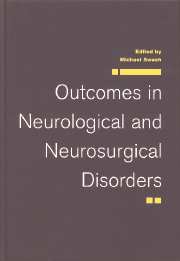Book contents
- Frontmatter
- Contents
- Contributors
- Preface
- I Introduction
- II Vascular disorders
- III Trauma to the central nervous system
- IV Tumours
- V Degenerative disease
- VI Infections of the central nervous system
- 19 Bacterial meningitis
- 20 Brain abscess
- 21 Viral infections of the nervous system
- VII Epilepsy, coma and other syndromes
- VIII Surgery for movement disorders and pain
- IX Rehabilitation
- Index
21 - Viral infections of the nervous system
from VI - Infections of the central nervous system
Published online by Cambridge University Press: 02 December 2009
- Frontmatter
- Contents
- Contributors
- Preface
- I Introduction
- II Vascular disorders
- III Trauma to the central nervous system
- IV Tumours
- V Degenerative disease
- VI Infections of the central nervous system
- 19 Bacterial meningitis
- 20 Brain abscess
- 21 Viral infections of the nervous system
- VII Epilepsy, coma and other syndromes
- VIII Surgery for movement disorders and pain
- IX Rehabilitation
- Index
Summary
Viral meningitis
Viral meningitis is a common illness, particularly amongst children, and is most often caused by enteroviruses. There is a tendency to equate the syndrome of aseptic meningitis with that of viral meningitis. A distinction should be made, however, since a large number of disorders with varying and sometimes serious outcomes can mimic viral meningitis. On the other hand, the prognosis of viral meningitis is very good, and the disease is rarely fatal, though death due to concurrent myocarditis has been reported in patients with coxsackievirus meningitis. Almost all patients with viral meningitis recover spontaneously; in those who develop serious neurological sequelae, care should be taken to exclude other aetiologies, such as partially treated bacterial meningitis.
The acute illness may be complicated by either complex partial seizures, physical evidence of increased intracranial pressure, or coma in approximately 9.0% of cases. The risk of acute neurological complications is slightly higher in neonates than in older children or adults, but appears to be similar among patients infected with group B coxsackie viruses and echoviruses, the two major enteroviruses causing viral meningitis. Follow-up studies have shown that 5–20% of patients with viral meningitis develop transient post-meningitic disorders, especially prolonged episodes of stress-induced headache. The risk of long-term neurological sequelae, however, is very small indeed (Table 21.1). Long-term prognosis in patients who develop acute complications appears to be as favourable as that for patients who do not experience acute complications.
Although the neurological outcome of viral meningitis is generally good, infection with certain viruses carries a less favourable outcome.
- Type
- Chapter
- Information
- Outcomes in Neurological and Neurosurgical Disorders , pp. 385 - 406Publisher: Cambridge University PressPrint publication year: 1998

